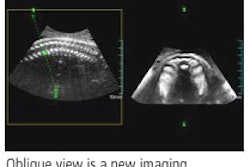Real-time ultrasound could offer significant advantages over the electrocardiogram for triggering heart scans, according to a preliminary study from the University of Michigan in Ann Arbor. The authors' ultrasound technique could potentially improve the quality and consistency of cardiac imaging with CT and MRI.
"The fundamental challenge with cross-sectional imaging of the heart is that the heart is a moving target, and there is a need to acquire image slices at the same point in the cardiac cycle from beat to beat," wrote Srini Tridandapani, Ph.D.; J. Brian Fowlkes, Ph.D.; and Dr. Jonathan Rubin, Ph.D., from the U of M's department of radiology.
ECG can depict the instantaneous electrical properties of the heart and predict its average spatial location, but it cannot determine the precise location of the heart from beat to beat. On the other hand, real-time echocardiography can determine the spatial properties of the heart, and can therefore be used to trigger slice acquisitions in cardiac CT or MRI scans, the authors wrote in the November Journal of Ultrasound in Medicine (Vol. 24:11, pp. 1519-1526).
Their study sought to compare the effectiveness of echocardiography with that of electrocardiography (ECG) for selecting phases within the cardiac cycle during which there is little heart motion.
The group examined two healthy volunteers (ages 57 and 38 years) on a System V/Vingmed ultrasound scanner (GE Healthcare, Chalfont St. Giles, U.K.), obtaining B-mode and M-mode images in the subxiphoid and left parasternal approaches using either a 2.5- or 5-MHz phased-array scan head. Simultaneous ECG data were also obtained with two leads, connected to the right and left anterior chest, respectively. The researchers used their own, as well as EchoMat (GE Healthcare), software routines for MATLAB (MathWorks, Natick, MA).
The ECG R wave was used to select the start of each cycle, the researchers wrote.
"Within each cycle, the range-gated M-mode data corresponding to the depth range that we selected were used, and a correlation was performed between the M-mode signal in each 4-millisecond interval of that cycle and the M-mode signal in each 4-millisecond interval of a subsequent cycle. The cross correlation was performed as follows: where c(t1, t2) was the two-time spatial correlation between the two vectors of M-mode data at times t1 (in the first cycle) and t2 (in a subsequent cycle); X(x,t) and st were the mean and the SD, respectively, of the M-mode data vector at time t; and d1 and d2 represented the lower and upper limits of the depth range of the M-mode signal considered," they wrote.
Time point pairs from each cycle could then be selected with correlation values above a specified threshold.
The results showed that beat-to-beat correlation values peaked at approximately 80% of the R-R interval near the cardiac apex, and around 30% of the R-R interval near the cardiac base for one subject. For the second subject, the correlation values peaked at approximately 75% of the R-R interval near the cardiac apex.
Consolidating the tolerance, or quiescent period, curves showed that the best time to trigger a CT scan would be slightly different between the two subjects, they wrote.
"These preliminary results show that our technique can provide a noninvasive method of quantifying and tracking relative cardiac motion within a cardiac cycle; it can potentially be used to determine the optimal trigger time and, furthermore, the duration of the quiescent period in the cardiac cycle when CT slices should be obtained," the authors explained.
They predicted that with further refinement, the technique could potentially eliminate the need for radiation-intensive retrospective CT acquisitions for coronary artery evaluation. Recent studies have shown that Agatston and volumetric scores are highly dependent on the reconstruction interval used, even with the most advanced CT scanners, meaning that patients could easily be directed to different risk groups depending on the reconstruction parameters used for their CT study, they added.
"In addition, using our method, one could theoretically gate during any portion of the heart cycle," the group wrote. "One would only need to estimate the correlation matches of the ultrasonic signals for sets of projections."
As for limitations, the presence of an ultrasound transducer could potentially produce a streak artifact on CT or a susceptibility artifact on MRI, though the single-element transducer used in the study could be designed to avoid this effect. In addition, a measure of proof is lacking because no CT or MR images were created using the results of their approach; a direct interface with a CT gantry will require collaboration with a scanner manufacturer. There was also criticism of examining just two subjects, the authors noted, but the authors stated that it was sufficient for the moment to demonstrate that the technique called for different scanning approaches for the two patients.
"The method has the potential to overcome some of the limitations of ECG, and thus improve the quality and consistency of cardiac and coronary artery cross-sectional imaging," they concluded.
By Eric Barnes
AuntMinnie.com staff writer
December 6, 2005
Related Reading
In phantom, MDCT edges EBT for calcium detection, October 11, 2005
Coronary calcium screening seen useful beginning between age 40 and 50, September 23, 2005
Low-dose CT calcium scores near-equivalent of higher dose, September 20, 2005
CT coronary calcium results vary by scanner, body type, May 31, 2005
ECG gating: Worth the dose for some lung indications, August 29, 2005
Copyright © 2005 AuntMinnie.com



















